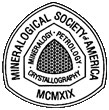 |
The Mineral Identification Key |  |
 |
The Mineral Identification Key |  |
Radioactivity is another property that, while not too common, is found in some minerals and can be useful in identification. Collectors who have a Geiger counter may find it useful at certain localities, particularly pegmatites – where many of the more common radioactive minerals are found – as well as sedimentary rocks in the Western United States.
Magnetism is not too prevalent in minerals, but in those that do exhibit it the property can be useful in making an identification. Having a small but strong magnet handy is a good idea, even if it only gets used now and then. The only strongly magnetic mineral collectors are likely to come across is, of course, magnetite. Some other minerals that may exhibit weak magnetism are pyrrhotite, ilmenite and franklinite.
A couple of other electrical properties found in minerals are piezoelectricity and pyroelectricity, though they are not common. They are also rather difficult to test for and won’t be covered here. Anyone interested in them can find information in most texts on mineralogy.
Acid Reactions: Reaction to acids is a property that can be used to help identify some carbonate minerals and zeolites. Dilute hydrochloric acid will react with carbonates such as calcite to give off appreciable bubbles of carbon dioxide in a relatively short period of time. Minerals such as dolomite have to be powdered (increasing surface area) to give an observable reaction. The zeolites will be attacked by acids, especially those zeolites that contain less silica. These minerals will become frosted in 5-10 minutes and will either dissolve or create a silica gel when grains are left in the acid for 24 hours.
ACIDS ARE DANGEROUS! Even weak acids can harm soft tissue, such as eyes and lungs. As with dealing with any hazardous substance, be sure to read, understand, and follow the labels and Material Safety Data Sheets for the proper methods for storing, using, disposing and appropriate emergency procedures for these materials. Always wear full-coverage splash proof lab goggles to protect your eyes when working with acids. Also have adequate ventilation when working with hydrochloric acid, especially the commonly available commercial strength solutions.
[ Table of Contents ] [ Introduction ] [ Identification Kit ] [ Mineral Properties ] [ Environments & Associations ] [ In Conclusion ] [ The Mineral ID Key ]